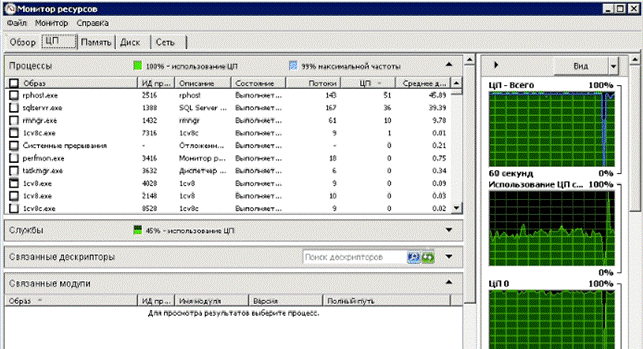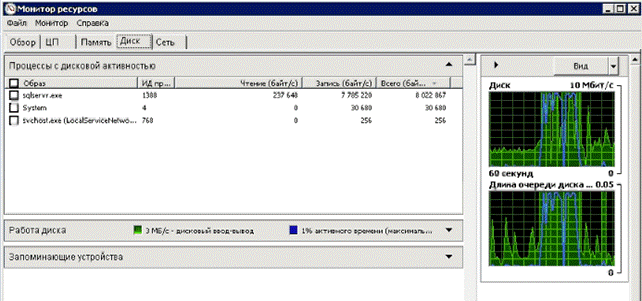Testing server 1C, DBMS MSSQL2008 on Windows 2008 OS on IBM x3650 M3 with 1 processor
Task setting: choosing the cheapest server for 1C server roles, MS SQL 2008 DBMS server for 50 users.
Iron selection using expert server :

')
According to the server expert , we collect iron:
Choosing a platform: IBM x3650 M3
Choosing a processor: Intel Xeon E5506 - 1pc.
Choosing RAM: 4 strips of 4GB
Choosing a hard disk: 3 SAS with 146 GB RAID5
Used software:
OS MS Windows 2008 x64
DBMS MS SQL 2008 x64
Server 1C 8.2 x64

Test environment: 1C 8.2 configuration was used for load testing: “Standard load test”.

Test progress:
On the local server, a 1C client session was started in agent mode and in test mode.
In the test configuration, the initial number of emulated standard 1C users was created, creating and deleting documents and reports equal to 20. The step of increasing the number of users after the tests was set to 20 users.

Initially (without user connections), the DBMS occupies 569 MB of RAM (2 databases are created: 1C 8.2 configuration: ACP and test configuration), the system's memory is 2.56 GB.
During testing (up to 110 users), the memory for the DBMS is allocated up to 12 GB, one test session of 1C takes 55 MB (55 MB 200 200 = 11 GB). For comparison - one real user session (1C client application) takes about 300 - 500 MB. The size of the memory allocated for the 1C client application is specified for the user working in the standard 1C: Trade or 1C: UPP configuration. The 1C server service (rphost) practically does not use OPs, since it only translates requests from the client side to the DBMS (according to the standard, TCP port 1541 and TCP 475 are used for the 1C protection server).


CPU utilization was divided between the 1C server service (rphost) and the DBMS service (sqlservr). With a load of 40 users, rphost occupied 37% of the CPU power, sqlservr occupied 30%. With a load of 60 users, rphost occupied 47% of the CPU power, sqlservr occupied 29%.


During the deletion of the created documents, the sqlsrvr service accessed the disk subsystem for recording at speeds up to 6.5 MB / s (about 52 Mbit / s).

The load on the network between the 1C server and the DBMS (on the local lookback interface) was 10 Mb / s.
Test result issued by test configuration 1C:
Parameters: Running the test 000000006 from 05/24/2012 12:44:16
Standard load test, version 2.0.4.11
Start of testing 05/23/2012 12:36:39. Execution time: 57.1 minutes.
Test conditions
«1C: Enterprise: test
Information base name: testcenter_82
Virtual users: TEST, »

Findings:
It is necessary to weaken the server configuration, since the current one is 100% redundant for 50 users.
It is necessary to perform testing using a second server to run the emulated users and check the network load, the expected load is 10 Mb / s.
The 1C architecture consists of 4 blocks: 1C server, DBMS, 1C protection server and 1C client. In this test, all these functions were run on the same server.
With a heavy load on the server 1C there are the following recommendations:
Spread the roles of 1C server, DBMS server, 1C protection server and 1C client applications (for faster performance, it is better to run 1C client applications on a terminal server).
On the DBMS server, the following structure should be used for data storage systems: OS should be located on RAID 1, DBMS data files (.mdf, .ndf) on a separate RAID 0, log files (.ldf) on a separate RAID 0, temporary files and a paging file on a separate disk.
Source: https://habr.com/ru/post/165695/
All Articles